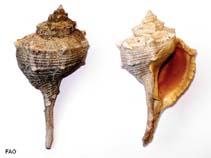Bolinus brandaris (Linnaeus, 1758)
Purple dye murex| Native range | All suitable habitat | Point map | Year 2050 |

|
| This map was computer-generated and has not yet been reviewed. |
| Bolinus brandaris AquaMaps Data sources: GBIF OBIS |
Classification / Names Common names | Synonyms | CoL | ITIS | WoRMS
Gastropoda | Neogastropoda | Muricidae
Environment: milieu / climate zone / depth range / distribution range Ecology
Benthic; depth range 1 - 200 m (Ref. 105998). Subtropical, preferred 20°C (Ref. 107945); 45°N - 30°N, 10°W - 36°E
Distribution Countries | FAO areas | Ecosystems | Occurrences | Introductions
Eastern Atlantic and the Mediterranean: from Portugal to central Morocco in the Atlantic, and east to Lebanon. Introduced in Atlantic Spain.
Length at first maturity / Size / Weight / Age
Maturity: Lm 5.6, range 4 - ? cm Max length : 10.8 cm ShL male/unsexed; (Ref. 127250); max. published weight: 79.70 g (Ref. 127250)
Life cycle and mating behavior Maturity | Reproduction | Spawning | Eggs | Fecundity | Larvae
Main reference
References | Coordinator | Collaborators
Museum of Natural History in Paris 2005 CLEMAM - Checklist of European Marine Mollusca - Public scientific database, consulted on [020606], hosted by Muséum National d'Histoire Naturelle (M.N.H.N.), Paris, at: http://www.mnhn.fr/biotaxis/clemam. Muséum National d'Histoire Naturelle (M.N.H.N.), Paris, at: http://www.mnhn.fr/biotaxis/clemam (Ref. 1056)
IUCN Red List Status
(Ref. 130435: Version 2025-1)
CITES status (Ref. 108899)
CMS (Ref. 116361)
Threat to humans
Human uses
Fisheries: commercial
| FishSource | Sea Around Us
Tools
More information
Max. ages / sizes
Length-weight rel.
Length-length rel.
Length-frequencies
Mass conversion
Abundance
Internet sources
BHL | BOLD Systems | CISTI | DiscoverLife | FAO(Publication : search) | Fishipedia | GenBank (genome, nucleotide) | GloBI | Gomexsi | Google Books | Google Scholar | Google | PubMed | Tree of Life | Wikipedia (Go, Search) | Zoological Record



